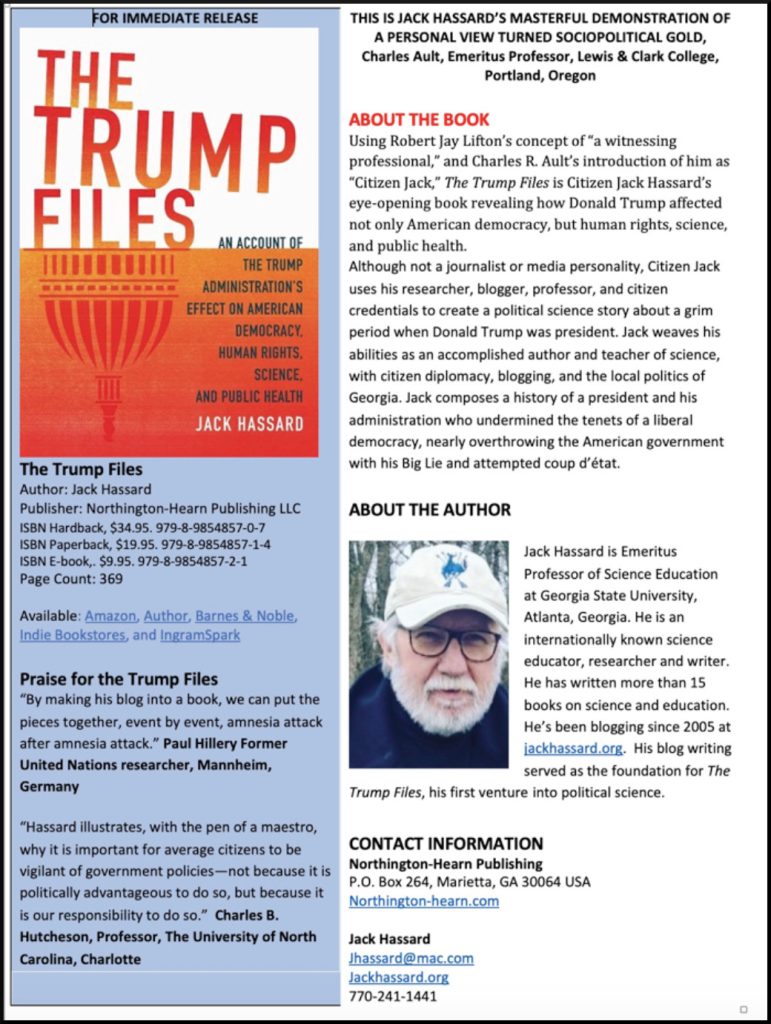Guest Post by Jack Hassard
For the past six months I’ve been marketing my newest book[1], The Trump Files, which was prepared for publication by Indigo: Editing, Design, and More, and I marketed it myself. I’m reporting to you that marketing my book created lots of anxiety, excitement, exhilaration, disappointment, success, and failure. But in the end, I realized that doing this is the way for me to share my passion for writing.
In July, my book was nearing completion. I now faced the task of promoting my book. I delved into the literature of book marketing and found a treasure chest of websites, publishing associations, and marketing authors.
One of the first websites I found was Scribe Media with free resources. One resource was a course about book launching, which I took and modified the content for my marketing goals. My goal was to get as many eyes as possible on my book by seeking to connect with an audience interested in politics and science, and how Trump affected American democracy, science, and public health. Here’s what I learned along the way.
Pre-Launch
One of the first actions I recommend is to develop a sell sheet, like the one shown in Figure 1. Do this before you begin a pre-launch. Note that this single page includes a photo of the book cover, the key data about the book, a couple of review blurbs, about the book, a bio (with a photo), and your contact information.

Figure 1
I set up a pre-publication schedule based on Scribe’s book launch suggestions. My launch date was September 27, 2022, and I began the pre-launch near the end of July. You can give more time to your pre-launch. On my next book, I definitely will.
My audience was made of people on my email list from previous contacts, my blog contacts, and professional and personal colleagues that I knew. Using Scribe’s suggestions, I divided my contacts into five categories: minimally engaged, moderately engaged, highly engaged, influencers (people with active websites and blogs who would write about or talk with others about my book), and reviewers. I recommend that you develop a spreadsheet of your audience (especially highly engaged, influencers, and reviewers) that includes data that will help you keep track of your contacts with them.
I cannot emphasize enough the importance of reaching out to others to hear their advice and ask names of people they know who might help you market your book. This action led me to five people who I refer to as my book sherpas. They became my guides to help navigate the marketing world. Your book sherpas will be amazingly helpful and will also give you emotional support and professional advice to keep you motivated.
I also identified and contacted independent (indie) bookstores, university bookstores that I had some association with (student, professor), and libraries. Create another spreadsheet for this group.
My pre-launch schedule looked like this:
- Two months out: Initial contact with my audience. I sent personal emails to my moderately and highly engaged groups, a digital copy of the book to influencers, and a letter to potential reviewers asking them if they would review the book. I sent a book to those who accepted my invitation.
- One month out: I emailed my highly engaged group members, reminding them of the book, and mailed a letter and hard copy of the book to influencers.
- One week out: I emailed my moderately engaged group.
- Launch week: Be sure to make the launch date a Tuesday (new book release day)! On Monday, I emailed the highly engaged group. On launch day, I sent an email to all engaged and influencers telling them, “It’s launch day.” On Friday, I sent an email to my full list that the book is out and asking them to share that information.
Post-Publication
Post-launch will be just as busy if not more so than pre-launch. I still spend at least an hour a day on post-launch activities. Here are some activities I have done:
- Design and publish an author dashboard on Amazon, Goodreads, Bookbub, or any of your favorite sites. The Amazon dashboard is the most used, so make sure you put the link to it on all your sites and contacts.
- Write and test ads on Amazon and Bookbub. Doing this will help you find keywords that work for you. It takes hard work to find the keywords that work for you. A tool I use is Publisher Rocket, for a small fee. It’s worth it.
- Send your sell sheet to bookstores and libraries in your state and any other indie or university bookstores you have connections with.
- Consider joining Amazon’s Kindle Select (for free).
- Run a Goodreads giveaway one or two months after your launch date.
- Contact journalists and newspapers about your book. I was very fortunate to have a columnist (who I contacted and asked for advice to market my book) include quotes from my book in his most recent column.
- Use your blog or website to market your book.
- Seek consumer reviews of your book and ask people to post them on Amazon and other retail booksellers’ websites.
Book marketing is a crucial profession that will bring your writing to the world of readers. I hope these suggestions will help you be a savvy book marketeer.
[1] Previous books include Minds on Science, The Whole Cosmos Catalog Science, Loving and Beyond, Holt Science, Science As Inquiry, The Art of Teaching Science, Environmental Science on the Net, and Science Experiences.
Jack Hassard is Emeritus Professor of Science Education at Georgia State University, Atlanta, Georgia. He is an internationally known science educator, researcher, and writer. He has written more than fifteen books on science and education. He’s been blogging since 2005 at jackhassard.org. His blog writing served as the foundation for The Trump Files.

Jack, good for you!!